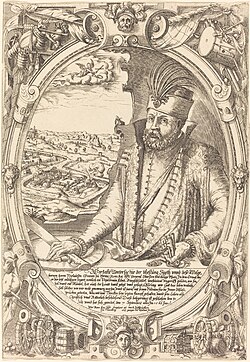
Back نقولا سوبيك زرنسكي Arabic نقولا سوبيك زرنسكى ARZ Никола Шубич Зрински Bulgarian Nikola Šubić Zrinski BS Miklós Zrínyi Catalan Mikuláš Šubič Zrinský Czech Nikola Šubić Zrinski German Miklós Zrínyi (heroo) Esperanto Nicolás Zrínyi Spanish نیکولا زرینسکی چهارم Persian
Nikola IV Zrinski Miklós IV Zrínyi | |
|---|---|
 A 16th-century engraving by Matthias Zündt | |
| Ban (Viceroy) of Croatia | |
| In office 24 December 1542 – 7 September 1556 | |
| Preceded by | Petar Keglević |
| Succeeded by | Péter Erdődy |
| Personal details | |
| Born | circa 1508 Zrin, Kingdom of Croatia |
| Died | 7 September 1566 (circa 58) Szigetvár, Kingdom of Hungary |
| Resting place | Pauline monastery in Sveta Jelena, Croatia |
| Spouse(s) | Katarina Frankopan Eva Rosenberg |
| Children | Ivan II, Jelena, Katarina, Juraj IV, Doroteja, Uršula, Barbara, Margareta, Magdalena, Ana, Kristofor, Nikola V, Ivan III |
| Parent(s) | Nikola III Zrinski Jelena Karlović |
| Signature | |
| Military service | |
| Battles/wars | Siege of Vienna (1529) Siege of Pest (1542) Battle of Babócsa (1556) Battle of Moslavina (1562) Siege of Szigetvár (1566) |
Nikola IV Zrinski or Miklós IV Zrínyi (Hungarian: Zrínyi Miklós, pronounced [ˈzriːɲi ˈmikloːʃ]; 1507/1508 – 7 September 1566), also commonly known as Nikola Šubić Zrinski (Croatian: [nǐkola ʃûbitɕ zrîːɲskiː]),[1][nb 1] was a Croatian nobleman and general, Ban of Croatia from 1542 until 1556, royal master of the treasury from 1557 until 1566, and a descendant of the Croatian noble families Zrinski and Kurjaković. During his lifetime the Zrinski family became the most powerful noble family in the Kingdom of Croatia.
Zrinski became well known across Europe for his involvement in the Siege of Szigetvár (1566), where he heroically died stopping Ottoman Empire's Sultan Suleiman the Magnificent's advance towards Vienna. The importance of the battle was considered so great that the French clergyman and statesman Cardinal Richelieu described it as "the battle that saved civilization".[5] Zrinski came to be considered a role model of a faithful and sacrificial warrior, Christian hero as well as a national hero in both Croatia and Hungary, and is often portrayed in artworks.
- ^ Pravopisna komisija (1960). Pravopis srpskohrvatskoga književnog jezika. Zagreb: Matica srpska, Matica hrvatska.
- ^ a b Mirnik, Ivan (2004), "Luc Orešković. Les Frangipani. Un exemple de la réputation des lignages au XVIIe siècle en Europe. Cahiers Croates. Hors-serie 1, 2003. Izdanje: Almae matris croaticae alumni (A.M.C.A.). Odgovoran za publikaciju: Vlatko Marić. Mali oktav, str. 151, 33 sl., 1 genealoška shema, 7 shematskih prikaza međusobnih odnosa, tablice s opisima grbova na 7 str. ISSN nedostaje (Review article)", Historical Contributions (in Croatian), 27 (27), Croatian Institute of History: 173 – via Hrčak - Portal znanstvenih časopisa Republike Hrvatske
- ^ Inoslav Bešker (7 September 2018). "450. Godišnjica bitke kod Sigeta: Sparta je imala svog Leonidu, a mi svoga Zrinskoga" [450. Anniversary of the Battle of Siget: Sparta had its Leonid, and we had our Zrinski] (in Croatian). Jutarnji list. Retrieved 3 July 2020.
- ^ Cite error: The named reference
CroEnc1was invoked but never defined (see the help page). - ^ Timothy Hughes Rare & Early Newspapers, Item 548456. Retrieved 1 December 2009.
Cite error: There are <ref group=nb> tags on this page, but the references will not show without a {{reflist|group=nb}} template (see the help page).
© MMXXIII Rich X Search. We shall prevail. All rights reserved. Rich X Search